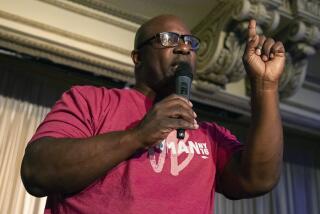Nader Comes Into Play in Unlikely Area
- Share via
WASHINGTON — Closing out an eight-month-long, $7-million shoestring presidential campaign, Green Party nominee Ralph Nader seemed set to affect the presidential elections where nobody expected it: Florida.
In the Sunshine State, where Republican Texas Gov. George W. Bush maintained a razor-thin margin over Democratic Vice President Al Gore, Nader drew nearly 100,000 votes, more than enough to tip the election in Gore’s direction.
Many pundits believe that many of those who voted for Nader would have cast their ballots for Gore, but Nader repeatedly had rebuffed pleas from Democratic leaders that he withdraw his candidacy.
Earlier Tuesday night, before the Florida race tightened dramatically, Nader hailed his performance and the future of the Green Party.
“We’re coming out of this election day with the third-largest party in America, replacing the Reform Party,” an ebullient Nader told several hundred celebrating supporters at the National Press Club here. “We are building a long-term progressive reform movement. That’s really quite an achievement.”
Many had expected Nader to influence the race most in states where the environment was a top issue: places such as Washington, Minnesota and Oregon. Although there is a strong environmental movement in Florida, few had predicted Nader would be a force there.
Nader long maintained that his goal was not to topple Gore, but win 5% of the popular vote in order to secure federal election funds for the Green Party in 2004.
However, the Green Party seemed far short of that goal early today, drawing about 3% of the vote.
Late Tuesday, Nader campaign manager Theresa Amato said, it seemed unlikely they would reach that threshold.
Nader, however, saw victory in laying the groundwork for a grass-roots movement that he hopes will merge local civic groups nationwide with the Green Party.
In the days after the election, Nader told the crowd, the Democratic and Republican parties will turn themselves into fund-raising machines to amass war chests for the next election cycle.
“The Green Party,” he said to wild cheers, “turns itself into a civic force.”
Before the polls closed, Nader was relaxed and reflective as he repeated his contention that, while drawing more than 5% of the vote would be a boon to the Green Party, the movement would continue regardless.
The consumer crusader predicted a third-party candidate could become a serious challenger for the White House within 12 years--or three presidential election cycles.
“It’s just a matter of organization,” Nader said Tuesday during a midday ride on Amtrak from Philadelphia to Washington, after finishing his campaign with a 1:30 a.m. rally in Portland, Maine. “It’s all out there, huge reservoirs of voters who are disenfranchised, discouraged, turned off.”
Nader said he plans to remain active in the Green Party even though he never joined it. He is registered as an independent in Connecticut, his home state.
Nader said he could be more useful to the group by advising it from the outside.
“The outside means you constantly broaden their frame of reference so they keep their eyes on the goal instead of engaging in infighting and disagreements that are not over serious matters,” he said. “That demoralizes people.”
Concerns Over the Perot Pitfall
Nader cited the fate of Ross Perot’s Reform Party, which splintered after Perot stepped away from the organization that he bankrolled and launched. Its disintegration follows a historical trend of third-party movements collapsing once their charismatic leader leaves.
Green Party activists said they recognize the problem but believe they will avoid it because the party predated Nader’s candidacy. Rather than following a charismatic leader, they said, the party attracted one.
“Nader is clearly the key,” said Greg Kelly, 29, a structural engineer from Richmond, Va., who voted for Bill Clinton in the last two elections. “In 2004, the difference between having Nader and not having Nader is huge. But I don’t think it’s a difference of life or death. Are we going to be huge in 2004 or just a lot bigger?”
Others were less optimistic.
“It could disappear very easily,” said David McMeans, 69, of Washington, who turned to the Nader campaign out of dislike for Gore and Bush. “The Green Party was so insignificant before him. Without someone like Nader, I don’t think it’s going to survive.”
Nader said the key to the Green Party’s future is to raise enough money to hire full-time organizers who can present the party’s positions to groups of potential supporters--from environmentalists to the working poor to public transit employees.
The organizational model already exists in the Public Interest Research Groups that Nader formed three decades ago, which have evolved into state-level, citizen-driven government watchdogs.
Using that model, he said, the Green Party will establish a network of storefront community centers in cities and towns nationwide, financed and staffed locally to organize neighborhoods and also to serve as advice hubs on dealing with government problems.
Such a permanent role will help build the party’s base support, Nader said.
“When you help them between elections, they start coming into the storefront and they see the Green Party is on their side,” he said.
More to Read
Get the L.A. Times Politics newsletter
Deeply reported insights into legislation, politics and policy from Sacramento, Washington and beyond. In your inbox twice per week.
You may occasionally receive promotional content from the Los Angeles Times.











